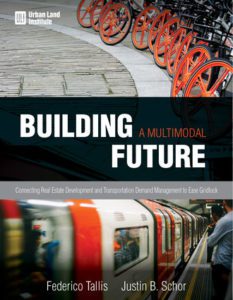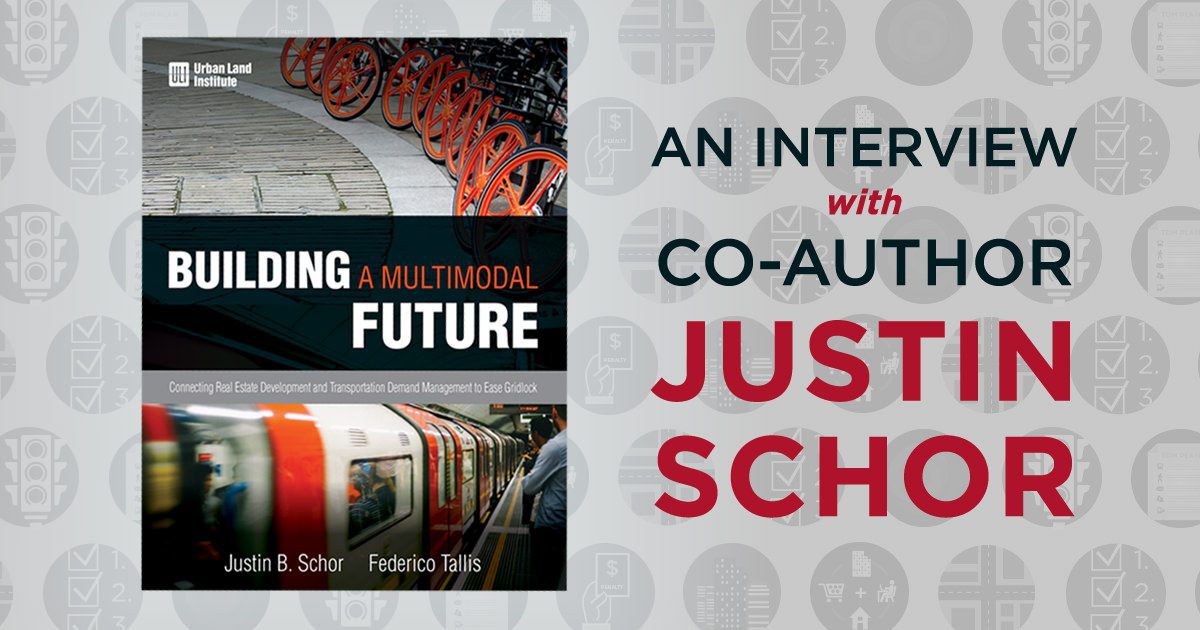
In May of this year, the Urban Land Institute (ULI) will publish a new handbook, Building a Multimodal Future: Connecting Real Estate Development and Transportation Demand Management to Ease Gridlock. On the eve of its publication, we sat down with co-author Justin Schor to review what people can expect from this new book.
Building a Multimodal Future is unique in that it presents real-life case studies for increasing density and reducing parking through effective transportation demand management (TDM) policies. Spread across the United States, these 10 examples – urban, suburban, and rural – offer perspectives of those who implement these policies and those who are affected by them, including developers, property owners, and managers, as well as other professionals who work with TDM policies.
In future interviews about this book and topic, we aim to get the perspectives of experts at and associated with the Urban Land Institute. Here are some comments from Justin about Building a Multimodal Future:
Q: Who is this book designed for?

A: The book is designed to help communities that want to be more urban and walkable with less parking, but whose citizens are concerned about traffic congestion as they densify.
We took into consideration the perspectives of both the local jurisdictions that have to develop and administer the TDM policies that ensure that traffic is reduced as well as the developers whose properties have to comply with them.
So, whether you are a developer or local government official, our hope is that this book provides not only a framework and best practices, but also that it will inspire developers and local government leaders to work together to create and apply TDM policies and strategies that will allow their communities to grow more sustainably, with increased density and mixed uses—and reduced traffic congestion.
“our hope is that this book provides not only a framework and best practices, but also that it will inspire developers and local government leaders to work together to create and apply TDM policies”
Q: What is Transportation Demand Management (TDM), in as few words as possible?
A: “Travel … behavior … change. It’s about encouraging and helping people to not drive on the roads or park in a parking lot during times when the demand for them is highest. That can be done by having less people driving alone in cars (e.g., bikes, buses, carpools, rail, and even electric scooters) or by having people travel during off-peak hours or even avoiding a trip completely.
Q: How does a community develop an effective TDM policy that overcomes NIMBY opposition to density?
A: In the book, we identify 9 steps to develop an effective TDM Policy:
- Understand How the TDM Policy Fits into the Planning Fabric of the Community
- Identify Where the TDM Policy Should Apply
- Determine the Types of Developments That Should Comply with the TDM Policy
- Select an Appropriate Metric to Quantify Site-Based Success
- Set the Appropriate Goal to Quantify Site-Based Success
- Establish How the TDM Policy Will Be Monitored
- Determine Appropriate TDM Strategies for Properties Affected by the TDM Policy
- Determine Whether a TDM Plan Is Required
- Decide on an Enforcement Mechanism to Ensure TDM Policy Compliance
Q: Across the different types of case study communities, what similarities did you find?
A: We identified six best practices that were common elements across the case study communities. These included:
- Focus on Outcome Rather Than Tactics
- Establish Quantifiable Performance Goals
- Verify Quantifiable Performance Goals with Monitoring and Evaluation
- Leverage Annual Reporting to Help TDM Programs Evolve over Time
- Invest Time Up Front to Establish Effective TDM Policy Administration
- Ensure Predictability with TDM in the Development Process
Q: And what about differences between the communities in how they approached improving their transportation networks?
A: Some of the biggest differences between the communities was how they approached measuring performance of development-based TDM programs.
For example, “Mode split” – the percentage of commuters driving alone versus the percentage not driving alone – was the most common metric used; six of the seven communities applied this metric.
“Trip reduction” – the percentage of auto trips reduced over time measured from a predetermined baseline – was the second most common metric, with two of the seven communities using that metric to determine success. One of the seven communities used traffic on the road to determine success. The remaining three jurisdictions without measurable performance benchmarks required new developments to implement the strategies in order to “check the box.”

